Investigation on the Fatigue Crack Propagation of Medium-Entropy Alloys with Heterogeneous Microstructures
Abstract
:1. Introduction
2. Materials and Methods
3. Results
3.1. Microstructures
3.2. Tensile Stress–Strain Curves and Nanoindentation Hardness
3.3. Fatigue Crack Propagation
4. Discussion
4.1. Quantitative Characterization of the Heterogeneous Microstructures
4.2. Mechanism of Fatigue Crack Propagation for MEAs with Different Heterogeneous Microstructures
5. Conclusions
- From the aspects of micro-morphology and micromechanical properties, the area percentage of recrystallization, hardness ratio of the hard and soft regions (HR), hardness difference of the hard and soft regions (HD), and coefficient of variation of all hardness (CoVH) are all candidate parameters for quantifying the heterostructured levels. When the parameters defined by different methods were associated with performance, different results were obtained.
- The damage of the fatigue crack growth mainly appeared in the cyclic plastic zone at the crack tips, which was equal to the size of the RGs in the order of magnitude. In this region, there are slip bands, deformation twinning, and some micro cracks along the twin boundary. There were no obvious changes in micro-morphology, orientation and lattice distortion observed outside the cyclic plastic zone.
- The fatigue crack growth path was deflected due to the orientation of grains at the crack tip, which changed the crack to a mixed-mode, decreased the stress intensity factor, and induced the roughness-induced crack closure effect. A larger recrystallization percentage and recrystallized grain size will increase the fatigue crack propagation threshold and decrease the crack growth rate.
Author Contributions
Funding
Data Availability Statement
Conflicts of Interest
References
- Wu, X.; Zhu, Y. Heterogeneous materials: A new class of materials with unprecedented mechanical properties. Mater. Res. Lett. 2017, 5, 527–532. [Google Scholar] [CrossRef]
- Wu, X.; Zhu, Y. Heterostructured Materials: Novel Materials with Unprecedented Mechanical Properties; Jenny Stanford Publishing Pte. Ltd.: Dubai, United Arabic Emirates, 2022; ISBN 978-1-003-15307-8. [Google Scholar]
- Ma, E.; Zhu, T. Towards strength–ductility synergy through the design of heterogeneous nanostructures in metals. Mater. Today 2017, 20, 323–331. [Google Scholar] [CrossRef]
- Li, J.; Zhang, Q.; Huang, R.; Li, X.; Gao, H. Towards understanding the structure—Property relationships of heterogeneous-structured materials. Scr. Mater. 2020, 186, 304–311. [Google Scholar] [CrossRef]
- Zhu, Y.; Ameyama, K.; Anderson, P.M.; Beyerlein, I.J.; Gao, H.; Kim, H.S.; Lavernia, E.; Mathaudhu, S.; Mughrabi, H.; Ritchie, R.O.; et al. Heterostructured materials: Superior properties from hetero-zone interaction. Mater. Res. Lett. 2020, 9, 1–31. [Google Scholar] [CrossRef]
- Wu, X.; Yang, M.; Yuan, F.; Wu, G.; Wei, Y.; Huang, X.; Zhu, Y. Heterogeneous lamella structure unites ultrafine-grain strength with coarse-grain ductility. Proc. Natl. Acad. Sci. USA 2015, 112, 14501–14505. [Google Scholar] [CrossRef] [PubMed]
- Fleck, N.A.; Kang, K.J.; Ashby, M.F. Overview no. 112: The cyclic properties of engineering materials. Acta Metall. Mater. 1994, 42, 365–381. [Google Scholar] [CrossRef]
- Pang, J.; Li, S.; Wang, Z.; Zhang, Z.F. Relations between fatigue strength and other mechanical properties of metallic materials. Fatigue Fract. Eng. Mater. Struct. 2014, 37, 958–976. [Google Scholar] [CrossRef]
- Pang, J.; Li, S.; Wang, Z.; Zhang, Z.F. General relation between tensile strength and fatigue strength of metallic materials. Mater. Sci. Eng. A 2013, 564, 331–341. [Google Scholar]
- Murakami, Y. Metal Fatigue: Effects of Small Defects and Nonmetallic Inclusions; Elsevier Science Ltd.: Oxford, UK, 2002; p. 57. ISBN 0-08-044064-9. [Google Scholar]
- Roland, T.; Retraint, D.; Lu, K.; Lu, J. Fatigue life improvement through surface nanostructuring of stainless steel by means of surface mechanical attrition treatment. Scr. Mater. 2006, 54, 1949–1954. [Google Scholar] [CrossRef]
- Huang, H.W.; Wang, Z.B.; Yong, X.P.; Lu, K. Enhancing torsion fatigue behaviour of a martensitic stainless steel by generating gradient nanograined layer via surface mechanical grinding treatment. Mater. Sci. Technol. 2013, 29, 1200–1205. [Google Scholar] [CrossRef]
- Huang, H.W.; Wang, Z.B.; Lu, J.; Lu, K. Fatigue behaviors of AISI 316L stainless steel with a gradient nanostructured surface layer. Acta Mater. 2015, 87, 150–160. [Google Scholar] [CrossRef]
- Shao, C.W.; Zhang, P.; Wang, X.G.; Wang, Q.; Zhang, Z.F. High-cycle fatigue behavior of TWIP steel with graded grains: Breaking the rule of mixture. Mater. Res. Lett. 2019, 7, 26–32. [Google Scholar] [CrossRef]
- Long, J.; Pan, Q.; Tao, N.; Dao, M.; Suresh, S.; Lu, L. Improved fatigue resistance of gradient nanograined Cu. Acta Mater. 2019, 166, 56–66. [Google Scholar] [CrossRef]
- Liu, R.; Tian, Y.Z.; Zhang, Z.J.; Zhang, P.; Zhang, Z.F. Fatigue strength plateau induced by microstructure inhomogeneity. Mater. Sci. Eng. A 2017, 702, 259–264. [Google Scholar] [CrossRef]
- Zerbst, U.; Vormwald, M.; Pippan, R.; Gänser, H.-P.; Sarrazin-Baudoux, C.; Madia, M. About the fatigue crack propagation threshold of metals as a design criterion—A review. Eng. Fract. Mech. 2016, 153, 190–243. [Google Scholar] [CrossRef]
- Lawson, L.; Chen, E.Y.; Meshii, M. Near-threshold fatigue:a review. Int. J. Fatigue 1999, 21, S15–S34. [Google Scholar] [CrossRef]
- Kikuchi, S.; Imai, T.; Kubozono, H.; Nakai, Y.; Ota, M.; Ueno, A.; Ameyama, K. Effect of harmonic structure design with bimodal grain size distribution on near-threshold fatigue crack propagation in Ti-6Al-4V alloy. Int. J. Fatigue 2016, 92, 616–622. [Google Scholar] [CrossRef]
- Si, Y.; Rouse, J.P.; Hyde, C.J. Potential difference methods for measuring crack growth: A review. Int. J. Fatigue 2020, 136, 105624. [Google Scholar] [CrossRef]
- Tirosh, J.; Peles, S. Bounds on the fatigue threshold in metals. J. Mech. Phys. Solids 2001, 49, 1301–1322. [Google Scholar] [CrossRef]
- Yang, M.; Yan, D.; Yuan, F.; Jiang, P.; Ma, E.; Wu, X. Dynamically reinforced heterogeneous grain structure prolongs ductility in a medium-entropy alloy with gigapascal yield strength. Proc. Natl. Acad. Sci. USA 2018, 115, 7224–7229. [Google Scholar] [CrossRef]
- Hong, Y.; Liu, X.; Lei, Z.; Sun, C. The formation mechanism of characteristic region at crack initiation for very-high-cycle fatigue of high-strength steels. Int. J. Fatigue 2016, 89, 108–118. [Google Scholar] [CrossRef] [Green Version]
- Oguma, N.; Harada, H.; Sakai, T. Mechanism of long life fatigue fracture induced by interior inclusion for bearing steel in rotating bending. J. Soc. Mater. Sci. 2003, 52, 1292–1297. [Google Scholar] [CrossRef]
- Sakai, T. Review and prospects for current studies on very high cycle fatigue of metallic materials for machine structural use. J. Solid Mech. Mater. Eng. 2009, 3, 425–439. [Google Scholar] [CrossRef]
- Sakai, T.; Oguma, N.; Morikawa, A. Microscopic and nanoscopic observations of metallurgical structures around inclusions at interior crack initiation site for a bearing steel in very high-cycle fatigue. Fatigue Fract. Eng. Mater. Struct. 2015, 38, 1305–1314. [Google Scholar] [CrossRef]
- Grad, P.; Reuscher, B.; Brodyanski, A.; Kopnarski, M.; Kerscher, E. Mechanism of fatigue crack initiation and propagation in the very high cycle fatigue regime of high-strength steels. Scr. Mater. 2012, 67, 838–841. [Google Scholar] [CrossRef]
- Kovacs, S.; Beck, T.; Singheiser, L. Influence of mean stresses on fatigue life and damage of a turbine blade steel in the VHCF-regime. Int. J. Fatigue 2013, 49, 90–99. [Google Scholar] [CrossRef]
- Hong, Y.; Sun, C.; Liu, X. A review on mechanisms and models for very-high-cycle fatigue of metallic materials. Adv. Mech. 2018, 48, 201801. [Google Scholar]

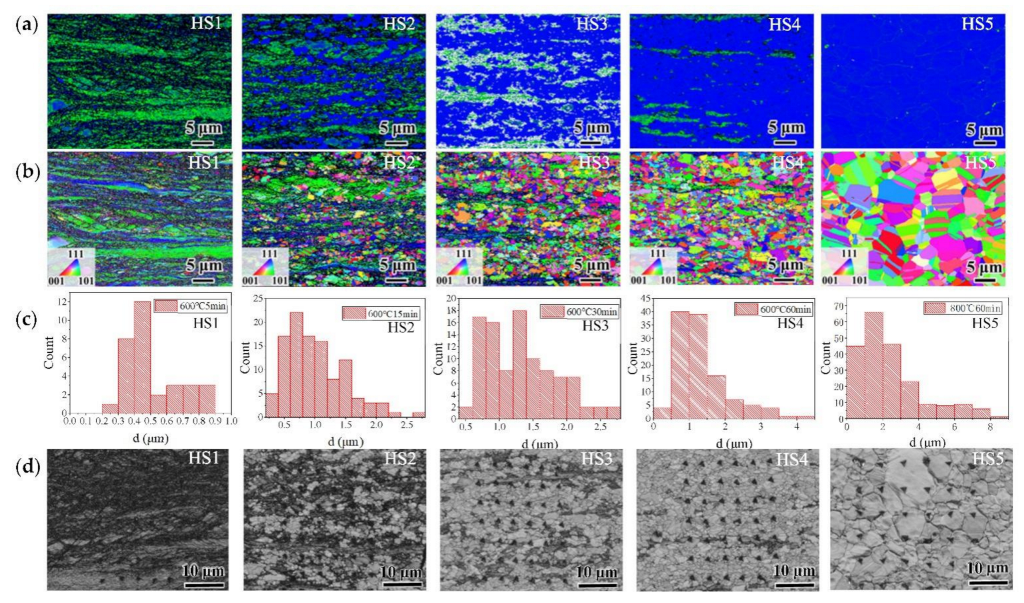

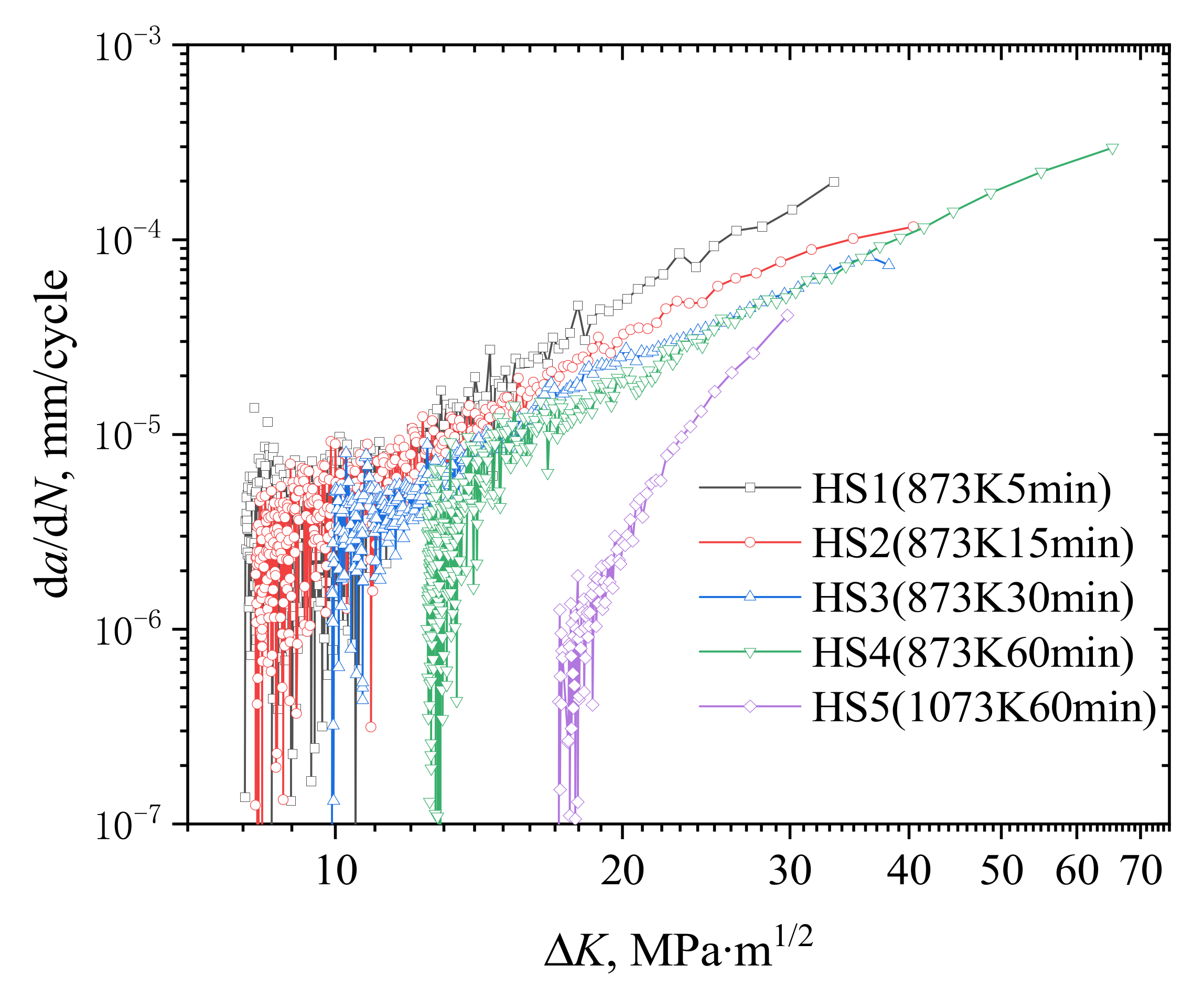
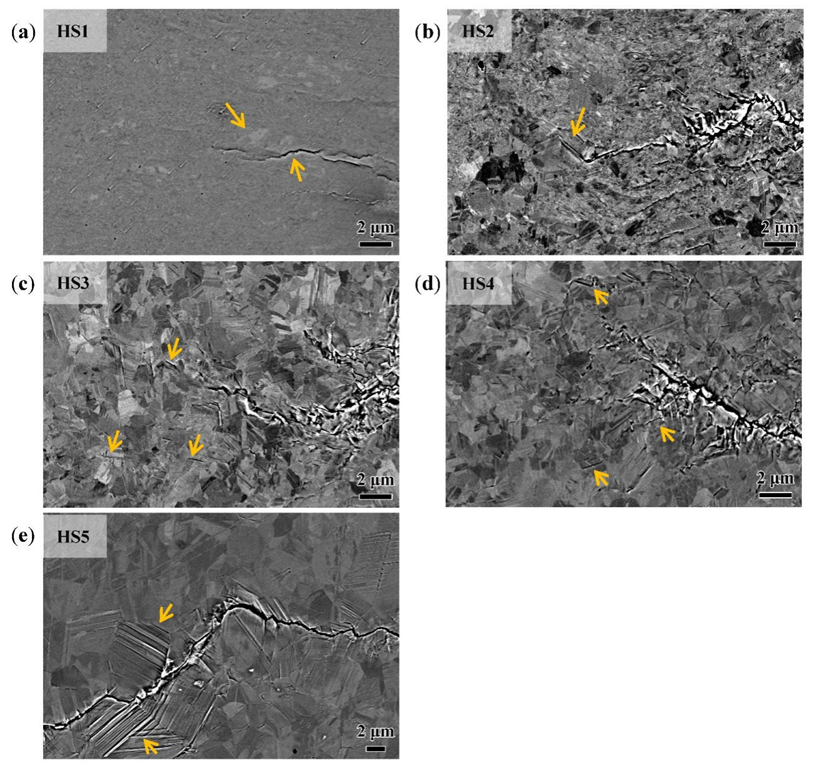
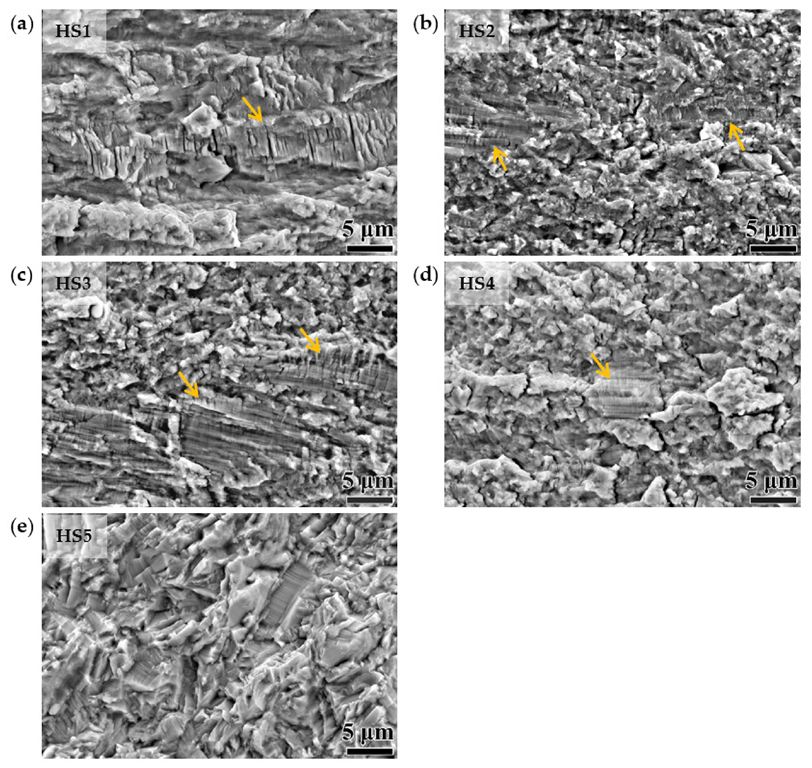

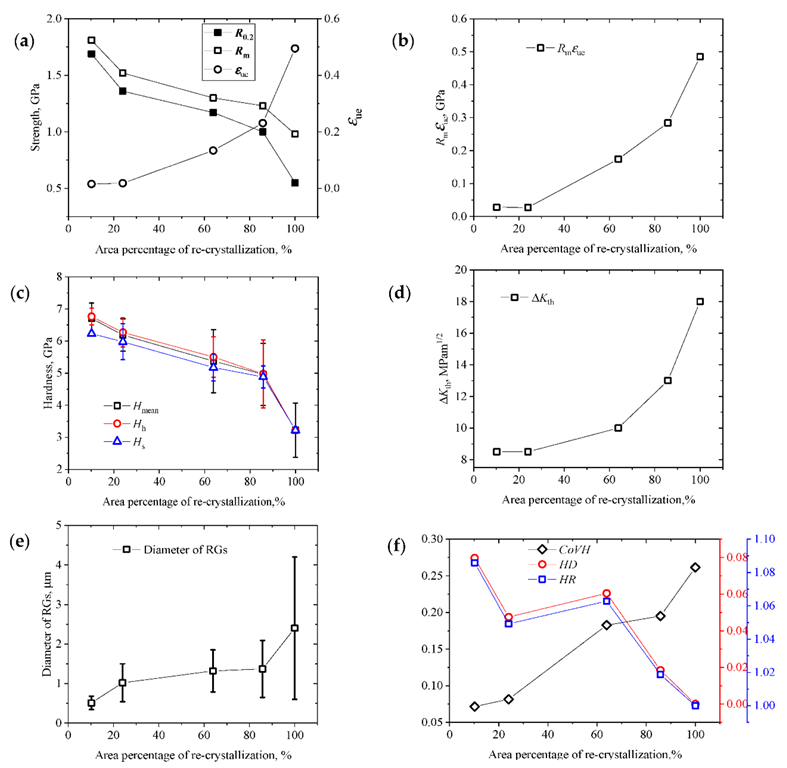
| Specimen | Annealing Process | Sizes of RGs μm | Area Percentage of Recrystallization | Hmean GPa | Hh GPa | Hs GPa | R0.2 GPa | εue | Rm GPa |
|---|---|---|---|---|---|---|---|---|---|
| HS1 | 600 °C 5 min | 0.51 ± 0.17 | 10.2% | 6.70 | 6.76 | 6.23 | 1.69 | 0.0154 | 1.81 |
| HS2 | 600 °C 15 min | 1.02 ± 0.48 | 24.0% | 6.19 | 6.27 | 5.98 | 1.36 | 0.0181 | 1.52 |
| HS3 | 600 °C 30 min | 1.32 ± 0.53 | 63.9% | 5.37 | 5.50 | 5.18 | 1.17 | 0.134 | 1.30 |
| HS4 | 600 °C 60 min | 1.37 ± 0.72 | 85.8% | 4.96 | 4.98 | 4.88 | 1.00 | 0.231 | 1.23 |
| HS5 | 800 °C 60 min | 2.4 ± 1.8 | 100% | 3.22 | 3.22 | 3.22 | 0.55 | 0.495 | 0.98 |
| Specimen | R0.2, GPa | ΔKth, MPam1/2 | Cyclic Plastic Zone Size at ΔKth, μm | Sizes of the RGs, μm | ΔK at the In Situ Testing, MPam1/2 | Cyclic Plastic Zone Size at the In Situ Testing, μm |
|---|---|---|---|---|---|---|
| HS1 | 1.69 | 8.5 | 0.33 | 0.51 ± 0.17 | 13.0 | 0.77 |
| HS2 | 1.36 | 8.5 | 0.51 | 1.02 ± 0.48 | 13.1 | 1.21 |
| HS3 | 1.17 | 9.9 | 0.94 | 1.32 ± 0.53 | 13.7 | 1.81 |
| HS4 | 1 | 12.9 | 2.18 | 1.37 ± 0.72 | 16.5 | 3.58 |
| HS5 | 0.55 | 17.9 | 13.9 | 2.4 ± 1.8 | 18.6 | 15.0 |
Publisher’s Note: MDPI stays neutral with regard to jurisdictional claims in published maps and institutional affiliations. |
© 2022 by the authors. Licensee MDPI, Basel, Switzerland. This article is an open access article distributed under the terms and conditions of the Creative Commons Attribution (CC BY) license (https://creativecommons.org/licenses/by/4.0/).
Share and Cite
Liu, Y.; Jiang, P.; Duan, G.; Wang, J.; Zhou, L.; Xie, J. Investigation on the Fatigue Crack Propagation of Medium-Entropy Alloys with Heterogeneous Microstructures. Materials 2022, 15, 6081. https://doi.org/10.3390/ma15176081
Liu Y, Jiang P, Duan G, Wang J, Zhou L, Xie J. Investigation on the Fatigue Crack Propagation of Medium-Entropy Alloys with Heterogeneous Microstructures. Materials. 2022; 15(17):6081. https://doi.org/10.3390/ma15176081
Chicago/Turabian StyleLiu, Yang, Ping Jiang, Guihua Duan, Jing Wang, Lingling Zhou, and Jijia Xie. 2022. "Investigation on the Fatigue Crack Propagation of Medium-Entropy Alloys with Heterogeneous Microstructures" Materials 15, no. 17: 6081. https://doi.org/10.3390/ma15176081






